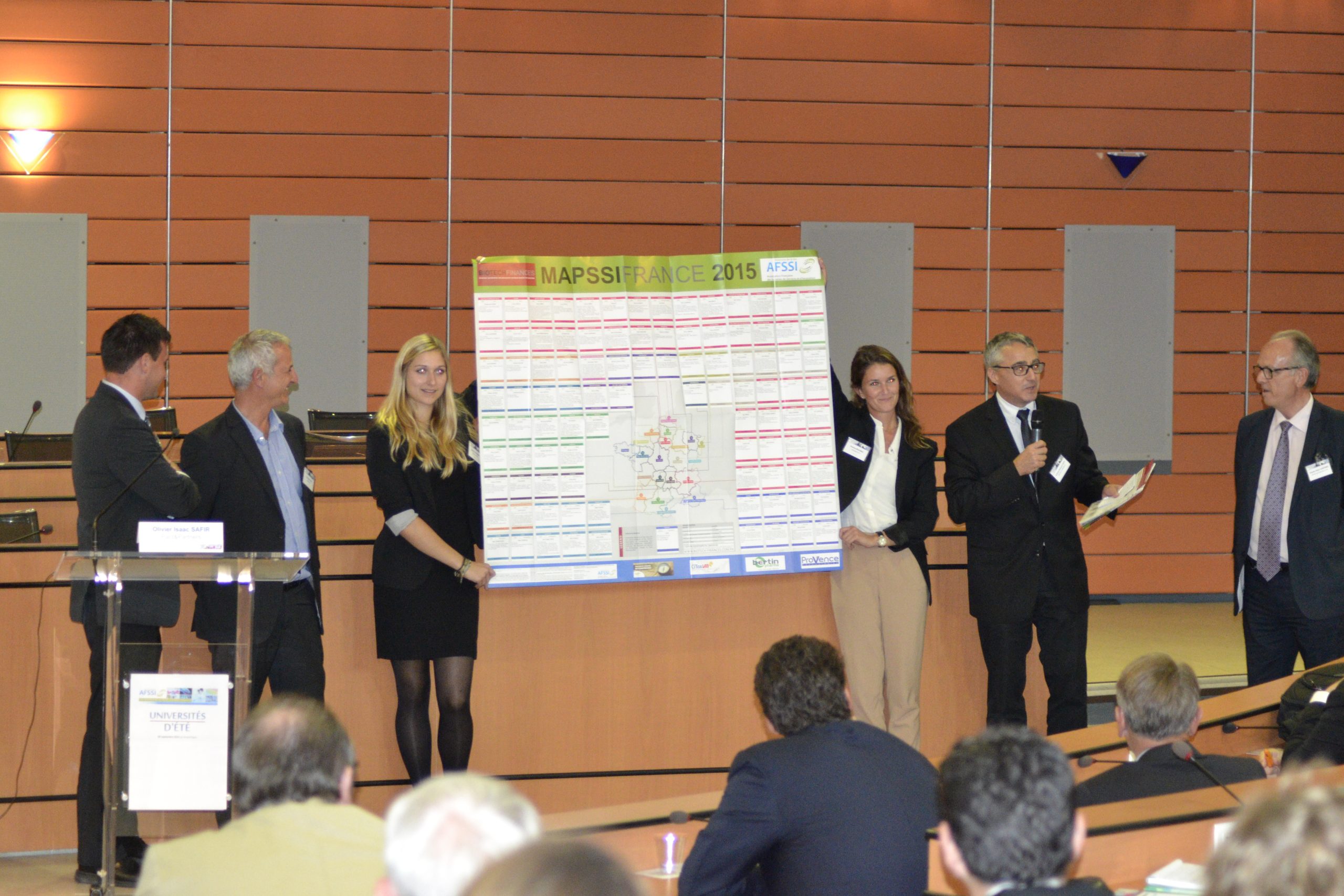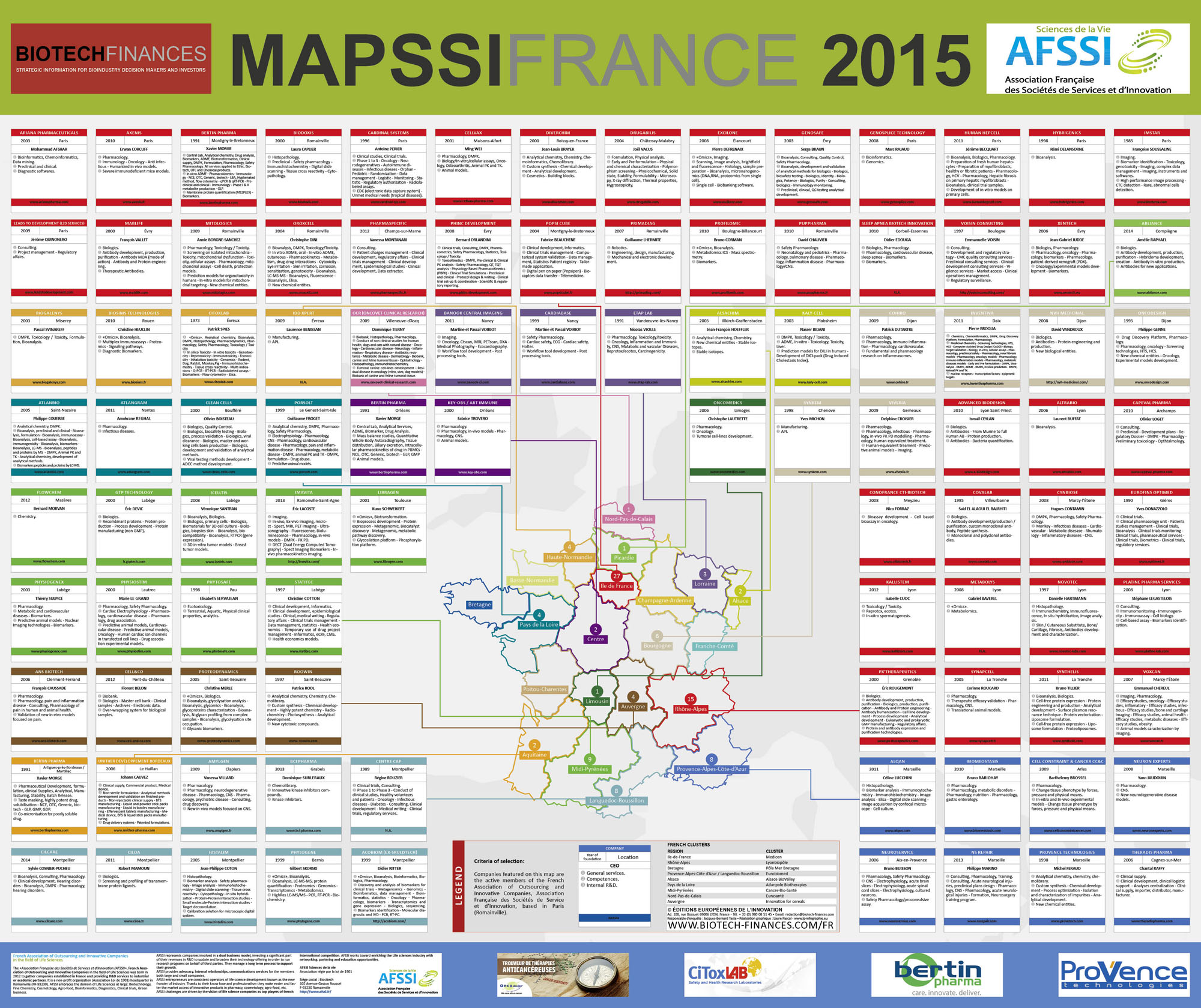Session posters scientifiques
Consultez les posters scientifiques qui ont été présentés aux AFSSI Connexions 2023 !
Offre FLASH unique : 1 stand commandé = votre hôtel **** offert
Réservez dès aujourd’hui notre dernier stand équipé disponible et profitez de 2 nuitées pour 2 personnes dans un hôtel **** sur le Vieux Port (Taxes de séjour et petits déjeuners inclus du 10 au 12 juillet. Commandez vite !
OroxCell, lauréat du meilleur poster scientifique
The potential of 3D reconstructed Human intestinal models for biowaiver studies and finished products testing
Authors: Rola Barcham (1), Eric Andres (1), Axel Huyard (1), Christophe Dini (1)
1 : Oroxcell, 102 avenue Gaston Roussel, 93230 Romainville, France
The BCS based regulatory biowaiver of clinical bioequivalence studies provides significant relief from the regulatory burden on the development of generic products as well as the ethical advantage of avoiding unnecessary exposure of healthy human volunteers. Over 50% of the world most used and essential oral, immediate-release drugs are estimated to fall into the BCS Class I and Class III classification, representing an enormous potential for companies developing generic formulations or managing the lifecycles of existing products to save money and time. In the context of in vitro studies, Caco-2 cell lines have become the most frequently used in vitro models to perform such studies.
The present work evaluates a novel primary human cell-based 3D organotypic small intestinal microtissues to be a potential pathway for evaluating in vitro bioequivalence, but also using formulated API to estimate the impact of formulation in promotion of absorption and to make comparison of adultversus pediatric forms which are currently in development, at doses corresponding to those employed in clinics. The permeability coefficients across the microtissues were determined for a panel of benchmark drugs with known human absorption.
The reference substances were accurately classified into low and high permeable drugs. The 3D organotypic Human small intestinal tissue model is eligible to elaborate a correlation curve according to BCS based biowaivers. The predicted fraction absorbed in human determined with the EpiIntestinal model was equivalent in both tested conditions, test adult form (capsule of 500 mg) vs. pediatric form (Sachet content of 500 mg). The object of this work is to give an insight into the added value that could bring the 3D organotypic Human small intestinal tissue model, over Caco-2 cells, for selecting appropriate formulations to improve systemic drug exposure or anticipate the impact of a change in formulation for generics or pediatric drug products.
Profitez d’un dispositif déployé pour vous associer de manière qualitative aux AFSSI Connexions.
Positionnez-vous comme un acteur majeur du secteur. Projetez-vous. Vous êtes au carrefour de l’innovation.
Sponsor MAPSSI
Affichez-vous sur l’édition 2017-1018 de la MAPSSI
Véritable mine d’informations – plébiscitée par tous les acteurs et opérateurs des sciences de la vie – la MAPSSI est un poster de 135cm par 115cm répertoriant les forces vives françaises des sociétés de services et d’innovation en Santé. La MAPSSI est éditée en partenariat avec Biotech Finances.
La MAPSSI sera à imprimée à 3000 exemplaires (soit 0,50€ par personne touchées)
Elle sera distribuée aux 400 participants des journées AFSSI et bénéficiera d’une mise en lumière particulière envers l’écoystème
3000 exemplaires imprimés,
soit 0,50€ le contact ciblé
ICI UN VISUEL
Sponsor GOLD
- All
- 1| Stand 16m²
- 2| Visibilité on-line
- 3| Visibilité sur place
- 4| Prise de parole
- 5| Vos accès gold
- 7| Divers
- Sponsor Gold
Accès à une session d’elevator pitch le 3 juillet. Présentation express de 2 minutes.
Discours introductif de présentation de votre société (en qualité de mécène) de quelques minutes à l’occasion de la soirée de gala.
- Stand modulaire de 16m²
(Base rectangulaire) - Mise à disposition 2 jours
- 1 table 4 chaises
- 3 chauffeuses, 1 table-basse
- Une banque d’accueil et un tabouret
- Présentoir
- Electricité, accès wifi, éclairage
- Signalétique lettrée
- 1 ou 2 angles ouverts
- 6 pass 2 jours offerts pour vous ou votre réseau (hors cabinets conseils extérieurs)
- Accès 6 personnes à la journée congrès
- Accès 6 personnes à la journée convention d’affaires
- Accès 6 personnes à l’outils de prise de rendez-vous
- Accès 6 personnes à la soirée de gala
- Des invitations supplémentaires à destination de donneurs d’ordre peuvent vous être mises à disposition sur demande
- 2 pages d’insertion publicitaire dans le programme des conférences remis sur place
- Programme (pdf) diffusé en amont au téléchargement sur le site internet et les réseaux sociaux
- Fichier fourni par vos soins
Engagez-vous sur deux éditions et bénéficiez de 30% de remise sur votre formule de sponsoring 2025 !
Chaque partenaire est unique !
Nos équipes seront à l’écoute de vos objectifs et contraintes pour vous proposer une formule adaptée et personnalisée. Votre réussite sera notre réussite !
- Un kakémono disposé sur le site de la manifestation
- Mise à disposition de vos plaquettes en libre service
- L’animation d’une session de présentation
Sous réserve d’acceptation par l’organisateur - Mention de votre intervention sur le programme de la manifestation
- Une chambre pour deux personnes dans un hôtel 3 étoiles
- Votre logo, film ou PowerPoint diffusé sur un écran plasma lors de l’événement
- Votre logo affiché sur uneide « sponsor » à l’occasion du congrès et des elevator pitches
- Annonce de notre sponsoring sur Twitter et LinkedIn
- Relais par nos partenaires
- Parution d’un post contextuel relatif à votre expertise sectorielle (en lien avec les thèmes AFSSI Connexions)
- Transmission d’un visuel personnalisé pour illustrer la diffusion de votre participation sur les réseaux sociaux
- Parution d’un post (Tweet / LinkedIn) de mise en situation vous affichant sur votre stand le jour J
- Votre logo sur nos campagnes emailings
- Campagnes adressées à 10 000 contacts qualifiés
- Campagnes diffusées en parallèle par nos relais de communication
- Votre logo affiché en bas de chaque emailing
- Votre logo sur la plaquette de commercialisation
- Votre logo sur le programme diffusé sur place
- Votre logo sur les affiches promotionnelles
- Votre logo sur les invitations
- Votre logo, lien web ainsi qu’un texte de présentation de votre société sur la page « Sponsor » du site internet (description fournie par vos soins)
- Affichage de votre logo et d’un lien vers votre site internet
- Positionnement en page d’accueil du site internet www.afssi.fr/afssi-connexions au sein de la rubrique sponsor
- Les sponsors d’une même catégorie seront affichés par ordre alphabétique
Sponsor GOLD
Accès à une session d’elevator pitch le 3 juillet. Présentation express de 2 minutes.
Discours introductif de présentation de votre société (en qualité de mécène) de quelques minutes à l’occasion de la soirée de gala.
- Stand modulaire de 16m²
(Base rectangulaire) - Mise à disposition 2 jours
- 1 table 4 chaises
- 3 chauffeuses, 1 table-basse
- Une banque d’accueil et un tabouret
- Présentoir
- Electricité, accès wifi, éclairage
- Signalétique lettrée
- 1 ou 2 angles ouverts
- 6 pass 2 jours offerts pour vous ou votre réseau (hors cabinets conseils extérieurs)
- Accès 6 personnes à la journée congrès
- Accès 6 personnes à la journée convention d’affaires
- Accès 6 personnes à l’outils de prise de rendez-vous
- Accès 6 personnes à la soirée de gala
- Des invitations supplémentaires à destination de donneurs d’ordre peuvent vous être mises à disposition sur demande
- 2 pages d’insertion publicitaire dans le programme des conférences remis sur place
- Programme (pdf) diffusé en amont au téléchargement sur le site internet et les réseaux sociaux
- Fichier fourni par vos soins
Engagez-vous sur deux éditions et bénéficiez de 30% de remise sur votre formule de sponsoring 2025 !
Chaque partenaire est unique !
Nos équipes seront à l’écoute de vos objectifs et contraintes pour vous proposer une formule adaptée et personnalisée. Votre réussite sera notre réussite !
- Un kakémono disposé sur le site de la manifestation
- Mise à disposition de vos plaquettes en libre service
- L’animation d’une session de présentation
Sous réserve d’acceptation par l’organisateur - Mention de votre intervention sur le programme de la manifestation
- Une chambre pour deux personnes dans un hôtel 3 étoiles
- Votre logo, film ou PowerPoint diffusé sur un écran plasma lors de l’événement
- Votre logo affiché sur uneide « sponsor » à l’occasion du congrès et des elevator pitches
- Annonce de notre sponsoring sur Twitter et LinkedIn
- Relais par nos partenaires
- Parution d’un post contextuel relatif à votre expertise sectorielle (en lien avec les thèmes AFSSI Connexions)
- Transmission d’un visuel personnalisé pour illustrer la diffusion de votre participation sur les réseaux sociaux
- Parution d’un post (Tweet / LinkedIn) de mise en situation vous affichant sur votre stand le jour J
- Votre logo sur nos campagnes emailings
- Campagnes adressées à 10 000 contacts qualifiés
- Campagnes diffusées en parallèle par nos relais de communication
- Votre logo affiché en bas de chaque emailing
- Votre logo sur la plaquette de commercialisation
- Votre logo sur le programme diffusé sur place
- Votre logo sur les affiches promotionnelles
- Votre logo sur les invitations
- Votre logo, lien web ainsi qu’un texte de présentation de votre société sur la page « Sponsor » du site internet (description fournie par vos soins)
- Affichage de votre logo et d’un lien vers votre site internet
- Positionnement en page d’accueil du site internet www.afssi.fr/afssi-connexions au sein de la rubrique sponsor
- Les sponsors d’une même catégorie seront affichés par ordre alphabétique
Accès à une session d’elevator pitch le 3 juillet. Présentation express de 2 minutes.
- Stand modulaire de 12m²
(Base rectangulaire) - Mise à disposition 2 jours
- 1 table 4 chaises
- Une banque d’accueil et un tabouret
- Présentoir
- Electricité, accès wifi, éclairage
- Signalétique lettrée
- 1 ou 2 angles ouverts
- 4 pass 2 jours offerts pour vous ou votre réseau (hors cabinets conseils extérieurs)
- Accès 4 personnes à la journée congrès
- Accès 4 personnes à la journée convention d’affaires
- Accès 4 personnes à l’outils de prise de rendez-vous
- Accès 4 personnes à la soirée de gala
- Des invitations supplémentaires à destination de donneurs d’ordre peuvent vous être mises à disposition sur demande
Engagez-vous sur deux éditions et bénéficiez de 30% de remise sur votre formule de sponsoring 2025 !
Chaque partenaire est unique !
Nos équipes seront à l’écoute de vos objectifs et contraintes pour vous proposer une formule adaptée et personnalisée. Votre réussite sera notre réussite !
- Un kakémono disposé sur le site de la manifestation
- Mise à disposition de vos plaquettes en libre service
- L’animation d’une session de présentation
Sous réserve d’acceptation par l’organisateur - Mention de votre intervention sur le programme de la manifestation
- 1 page d’insertion publicitaire dans le programme des conférences remis sur place
- Programme (pdf) diffusé en amont au téléchargement sur le site internet et les réseaux sociaux
- Fichier fourni par vos soins
- Votre logo, film ou PowerPoint diffusé sur un écran plasma lors de l’événement
- Votre logo affiché sur uneide « sponsor » à l’occasion du congrès et des elevator pitches
- Annonce de notre sponsoring sur Twitter et LinkedIn
- Relais par nos partenaires
- Parution d’un post contextuel relatif à votre expertise sectorielle (en lien avec les thèmes AFSSI Connexions)
- Transmission d’un visuel personnalisé pour illustrer la diffusion de votre participation sur les réseaux sociaux
- Parution d’un post (Tweet / LinkedIn) de mise en situation vous affichant sur votre stand le jour J
- Votre logo sur nos campagnes emailings
- Campagnes adressées à 10 000 contacts qualifiés
- Campagnes diffusées en parallèle par nos relais de communication
- Votre logo affiché en bas de chaque emailing
- Votre logo sur la plaquette de commercialisation
- Votre logo sur le programme diffusé sur place
- Votre logo sur les affiches promotionnelles
- Votre logo sur les invitations
- Votre logo, lien web ainsi qu’un texte de présentation de votre société sur la page « Sponsor » du site internet (description fournie par vos soins)
- Affichage de votre logo et d’un lien vers votre site internet
- Positionnement en page d’accueil du site internet www.afssi.fr/afssi-connexions au sein de la rubrique sponsor
- Les sponsors d’une même catégorie seront affichés par ordre alphabétique
- Stand modulaire de 8m²
(Base rectangulaire) - 1 table 4 chaises
- Mise à disposition 2 jours
- Présentoir
- Electricité, accès wifi, éclairage,
- Signalétique lettrée
Accès à une session d’elevator pitch le 3 juillet. Présentation express de 2 minutes.
- Mise à disposition de vos plaquettes en libre-service aux endroits stratégiques de la manifestation et lors de la soirée de gala
- 1/2 pages d’insertion publicitaire dans le programme des conférences remis sur place
- Programme (pdf) diffusé en amont au téléchargement sur le site internet et les réseaux sociaux
- Fichier fourni par vos soins
Engagez-vous sur deux éditions et bénéficiez de 30% de remise sur votre formule de sponsoring 2025 !
Chaque partenaire est unique !
Nos équipes seront à l’écoute de vos objectifs et contraintes pour vous proposer une formule adaptée et personnalisée. Votre réussite sera notre réussite !
- 2 pass 2 jours offerts pour vous ou votre réseau (hors cabinets conseils extérieurs)
- Accès 2 personnes à la journée congrès
- Accès 2 personnes à la journée convention d’affaires
- Accès 2 personnes à l’outils de prise de rendez-vous
- Accès 2 personnes à la soirée de gala
- Des invitations supplémentaires à destination de donneurs d’ordre peuvent vous être mise à disposition sur demande
- Votre logo, film ou PowerPoint diffusé sur un écran plasma lors de l’événement
- Votre logo affiché sur uneide « sponsor » à l’occasion du congrès et des elevator pitches
- Annonce de notre sponsoring sur Twitter et LinkedIn
- Relais par nos partenaires
- Parution d’un post contextuel relatif à votre expertise sectorielle (en lien avec les thèmes AFSSI Connexions)
- Transmission d’un visuel personnalisé pour illustrer la diffusion de votre participation sur les réseaux sociaux
- Parution d’un post (Tweet / LinkedIn) de mise en situation vous affichant sur votre stand le jour J
- Votre logo sur nos campagnes emailings
- Campagnes adressées à 10 000 contacts qualifiés
- Campagnes diffusées en parallèle par nos relais de communication
- Votre logo affiché en bas de chaque emailing
- Votre logo sur la plaquette de commercialisation
- Votre logo sur le programme diffusé sur place
- Votre logo sur les affiches promotionnelles
- Votre logo sur les invitations
- Votre logo, lien web ainsi qu’un texte de présentation de votre société sur la page « Sponsor » du site internet (description fournie par vos soins)
- Affichage de votre logo et d’un lien vers votre site internet
- Positionnement en page d’accueil du site internet www.afssi.fr/afssi-connexions au sein de la rubrique sponsor
- Les sponsors d’une même catégorie seront affichés par ordre alphabétique
-
- Stand modulaire de 8m²
(Base rectangulaire) - 1 table 4 chaises
- Mise à disposition 2 jours
- Stand modulaire de 8m²
- Présentoir
- Electricité, accès wifi, éclairage,
- Signalétique lettrée
- Mise à disposition 2 jours





